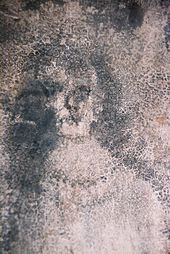Bélmez Faces facts for kids
The Bélmez Faces are a supposed paranormal event that happened in a private house in Spain. It all started in 1971 when people living there claimed that images of faces appeared on the concrete floor of their home.
This house belongs to the Pereira family and is located at Calle Real 5, in a town called Bélmez de la Moraleda, in the Jaén region of Spain. The Bélmez faces have attracted many visitors to the town.
Since 1971, different faces have supposedly shown up and then disappeared at random times. Local newspapers and curious visitors often took pictures of them. Many people in Bélmez believe that these faces were not made by human hands. Some people who study paranormal events think it's a thoughtographic phenomenon. This means they believe the faces were somehow created by the thoughts of the house's former owner, María Gómez Cámara, after she had died.
However, skeptical researchers have looked into the faces very closely. They believe the faces are fake and might have been part of a hoax. It's thought that the Pereira family might have created the hoax to make money.
Contents
What Happened in Bélmez?
Reports of the faces appearing in Bélmez began on August 23, 1971. María Gómez Cámara said that a human face suddenly formed on her kitchen floor, which was made of concrete. María's husband, Juan Pereira, and their son, Miguel, tried to get rid of the image using a pickaxe. They then put down new concrete. But, according to the Pereira family, a new face appeared on the floor.
The mayor of Bélmez heard about this and told them not to destroy the new face. Instead, the concrete section with the face was cut out and taken away for study.
María's home became known to tourists as La Casa de las Caras, which means "The House of the Faces." By Easter of 1972, hundreds of people were visiting the house to see the faces. For the next 30 years, the Pereira family claimed that faces kept appearing. These faces were both male and female, and they had different shapes, sizes, and expressions.
Investigating the Faces
Several groups and individuals have investigated the Bélmez case.
Was it a Hoax?
Many researchers believe the faces were a trick or a hoax. In 1993, a researcher named Luis Ruiz-Noguez wrote an article. He mentioned that chemicals used in paint, like zinc, lead, and chromium, were found in the faces. He thought lead was likely used because it was common in paints and could create dark colors.
Another researcher, Manuel Martín Serrano, wrote a book called Sociología del Milagro (Sociology of the Miracle). He interviewed many people in Bélmez. Serrano believed the faces were a hoax made to earn money.
José Luis Jordán, who was a vice-president of a Spanish parapsychology society, was also very doubtful. In 1971, a part of the Spanish Ministry of the Interior asked Jordán to lead a group of experts. These experts studied the strange events in Bélmez. Jordán's report looked at different ways the faces could have been faked. He suggested things like "pigmentation with a dark substance" or "a mix of soot and vinegar." He also mentioned "the strong action of a chemical compound."
Jordán later said in an interview that he found a German product in drugstores that removes concrete stains. He believed this product could make images invisible at first and then appear later.
Ramos Perera, another expert, also thought the faces were fake. He said that infrared photography showed that "La Pava," one of the most famous Bélmez faces, had added color. He even said they could see paintbrush bristles. This made them sure it had been painted. "La Pava" was later put into the wall of María's home for people to see.
Other chemical tests were done by J.J. Alonso. His results were not clear about how the images were formed. He also didn't say if he believed the "thoughtographic" claims. However, his tests did confirm the presence of a dark, cement-like compound.
The "Mind-Made" Faces Idea
The main researchers who believed in the paranormal origin of the Bélmez faces were Hans Bender and Germán de Argumosa. They worked together in the early 1970s. Bender mentioned the case in his lectures. He said that slight changes in the faces happened even when they were sealed with plastic, which a notary (a legal official) confirmed. This made him think the faces were truly paranormal.
José Martínez-Romero wrote a book about the case, but some people felt it made the phenomenon seem less believable. Andrew Carr MacKenzie also wrote about it in his book The Seen and the Unseen.
New Faces, New Questions
María Gómez, the woman who supposedly caused the faces to appear, passed away in February 2004. She was 85 years old. After her death, a psychic researcher named Pedro Amorós tried to find more "thoughtographic" faces in Gómez's house. This led to a new set of Bélmez faces appearing.
However, Amorós's claims were soon proven false by the Spanish media. In November 2004, the newspaper El Mundo published an article titled "New Belmez Faces Faked by 'Ghostbusters' and Municipal Government."
In May 2007, journalist Javier Cavanilles and investigator Francisco Máñez wrote a book called Los Caras de Bélmez. This title has a double meaning: "The Faces of Bélmez" and "The Scoundrels of Bélmez." In their book, they explained the history of the scam. They pointed to María's son, Diego Pereira, as the person who created the mysterious paintings.
See also
 In Spanish: Caras de Bélmez para niños
In Spanish: Caras de Bélmez para niños
- List of allegedly haunted locations
- Thoughtography
- Pareidolia


